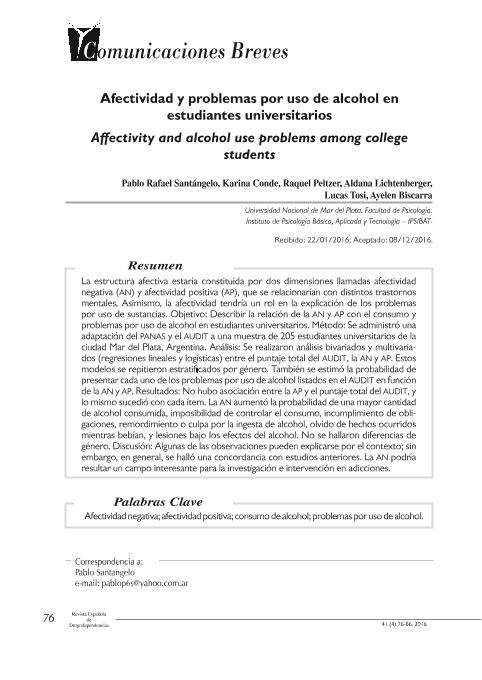Artículo
La estructura afectiva estaría constituida por dos dimensiones llamadas afectividad negativa (AN) y afectividad positiva (AP), que se relacionarían con distintos trastornos mentales. Asimismo, la afectividad tendría un rol en la explicación de los problemas por uso de sustancias. Objetivo: Describir la relación de la AN y AP con el consumo y problemas por uso de alcohol en estudiantes universitarios. Método: Se administró una adaptación del PANAS y el AUDIT a una muestra de 205 estudiantes universitarios de la ciudad Mar del Plata, Argentina. Análisis: Se realizaron análisis bivariados y multivariados(regresiones lineales y logísticas) entre el puntaje total del AUDIT, la AN y AP. Estos modelos se repitieron estratificados por género. También se estimó la probabilidad de presentar cada uno de los problemas por uso de alcohol listados en el AUDIT en función de la AN y AP. Resultados: No hubo asociación entre la AP y el puntaje total del AUDIT, y lo mismo sucedió con cada ítem. La AN aumentó la probabilidad de una mayor cantidad de alcohol consumida, imposibilidad de controlar el consumo, incumplimiento de obligaciones, remordimiento o culpa por la ingesta de alcohol, olvido de hechos ocurridos mientras bebían, y lesiones bajo los efectos del alcohol. No se hallaron diferencias de género. Discusión: Algunas de las observaciones pueden explicarse por el contexto; sin embargo, en general, se halló una concordancia con estudios anteriores. La AN podría resultar un campo interesante para la investigación e intervención en adicciones. The affective structure consists of two dimensions: positive affectivity (PA) and negative affectivity (NA), which would be related to various mental disorders and may also have a role in explaining substance use problems. Aims: To describe the relationship between NA and PA with alcohol consumption and alcohol use problems in college students. Method: an adaptation of the PANAS and AUDIT was administered to a sample of 205 college students from the city of Mar del Plata, Argentina. Analysis: bivariate and multivariate analysis (linear and logistic regressions) were performed between the total AUDIT score, NA and PA, and were then repeated stratified by gender. The probability of presenting an alcohol use disorder listed by the AUDIT, according to the PA and NA, was also estimated. Results: There was no association between the PA and the total AUDIT score, and the same thing occurred with each item. NA increases the likelihood of consuming more alcohol, inability to control consumption, failure to comply with obligations, remorse or guilt at alcohol consumption, forgetting events while drinking, and injury under the effects of alcohol. No gender differences were found. Discussion: Although results are consistent with previous studies, some of the observations can be explained by the context. NA could be an interesting field in research into addictions.
Afectividad y problemas por uso de alcohol en estudiantes universitarios
Título:
Affectivity and alcohol use problems among college students
Santangelo, Pablo; Conde, Karina Natalia ; Peltzer, Raquel Inés; Lichtenberger, Aldana
; Peltzer, Raquel Inés; Lichtenberger, Aldana ; Tosi, Lucas; Biscarra, Maria Ayelen
; Tosi, Lucas; Biscarra, Maria Ayelen
 ; Peltzer, Raquel Inés; Lichtenberger, Aldana
; Peltzer, Raquel Inés; Lichtenberger, Aldana ; Tosi, Lucas; Biscarra, Maria Ayelen
; Tosi, Lucas; Biscarra, Maria Ayelen
Fecha de publicación:
12/2016
Editorial:
Asociación Española de Estudio en Drogodependencias
Revista:
Revista Española de Drogodependencias
ISSN:
0213-7615
Idioma:
Español
Tipo de recurso:
Artículo publicado
Clasificación temática:
Resumen
Palabras clave:
Afectividad Negativa
,
Consumo de Alcohol
,
Problemas por Uso De Alcohol
Archivos asociados
Licencia
Identificadores
Colecciones
Articulos(CCT - MAR DEL PLATA)
Articulos de CTRO.CIENTIFICO TECNOL.CONICET - MAR DEL PLATA
Articulos de CTRO.CIENTIFICO TECNOL.CONICET - MAR DEL PLATA
Citación
Santangelo, Pablo; Conde, Karina Natalia; Peltzer, Raquel Inés; Lichtenberger, Aldana; Tosi, Lucas; et al.; Afectividad y problemas por uso de alcohol en estudiantes universitarios
; Asociación Española de Estudio en Drogodependencias; Revista Española de Drogodependencias; 4; 12-2016; 76-86
Compartir



